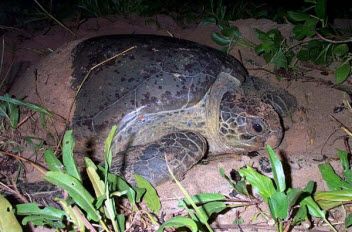Oil and Sea Turtles: Biology, Planning, and Response
Oil and Sea Turtles presents a basic overview of sea turtle biology, summarizes what is known about the effects of oil on sea turtles, reviews potential response actions in the event of a release, and presents case histories from previous spills.
This guidance document is the third in a series of publications prepared by NOAA's Office of Response and Restoration to provide response-related information on specific warm-water resources. Other publications in the series can be accessed through the blue navigation bar at the page top.
Download the Guide: Oil and Sea Turtles: Biology, Planning, and Response [PDF, 7.0 MB]. Originally published in 2003 and reprinted in 2010, the report was updated in August 2021 to include enhanced knowledge from the response and Natural Resource Damage Assessment for the Deepwater Horizon oil spill.
More Information about Sea Turtles
How Do Oil Spills Affect Sea Turtles?: This article includes three infographics depicting sea turtle life history, potential impacts of oil on sea turtles, and potential impacts of response actions on sea turtles.
Story Map: Oil Spill Response and Assessment for Sea Turtles: A NOAA story map depicting and explaining sea turtle biology and lifecycle, vulnerability to oil, key elements of oil spill response, natural resource damage assessment, and laws and regulations.
Sea Turtle Restoration: A 14-page fact sheet produced by the Open Ocean Restoration Area.
Learn more about the spill incidents referenced in the report, Oil and Sea Turtles:
Barge Morris J. Berman: On January 7, 1994, the barge Morris J. Berman went aground in the surf zone off Escambron Beach in San Juan, Puerto Rico.
Barge Morris J. Berman Spill: NOAA's Scientific Response [PDF, 1.8 MB]: This 1995 report discusses major response issues related to the 1994 grounding of the tank barge Morris J. Berman in San Juan, Puerto Rico.
Fort Lauderdale, Florida, Mystery Spill: At approximately 10 am, August 8, 2000, NOAA was notified of a mystery oil spill washing up on the beaches from North Miami to Pompano, spanning approximately 25 miles of the east coast of Florida.
Oil Tanker SS Witwater: On December 13, 1968, the oil tanker Witwater broke up in heavy seas off the Atlantic coast of Panama.
Ixtoc I Well Blowout: On June 3, 1979, the 2-mile deep exploratory well, IXTOC I, blew out in the Bahia de Campeche, 600 miles south of Texas in the Gulf of Mexico.
Nowruz Oil Spill: In 1983, the Nowruz Oil Field in the Persian Gulf, Iran, was involved in a number of oil pollution incidents.
Oil Tanker Alvenus: On July 30, 1984, the U.K. Tank Vessel Alvenus grounded in the Calcasieu River Bar Channel 11 miles southeast of Cameron, Louisiana.
Barge Vista Bella: On March 6, 1991, the Vista Bella sank in the Atlantic Ocean approximately 12 miles northeast of Nevis Island (British).
Barge Bouchard B155: On August 10, 1993, the freighter Balsa 37, the barge Ocean 255, and the barge Bouchard 155 collided in the shipping channel west of the Skyway Sunshine Bridge south of Mullet Key in Tampa Bay, Florida.
Oil Spill Case Histories: 1967 through 1991 [PDF, 1.7 MB]: This document summarizes significant U.S. and international spills between 1967 and 1991. In the Bookmarks section on the left, click the name of a spill: Alvenus, IXTOC I, Nowruz Oil Field, Vista Bella, and Witwater.
Oil and Hazardous Materials Response Reports: This page offers summaries of oil and chemical spill responses in which NOAA OR&R participated between September 1992 and September 1999. To read about the barge Bouchard 155 spill response, choose "Response Reports: 1993." To read about the Morris J. Berman response, choose "Response Reports: 1994."
 An official website of the United States government.
An official website of the United States government. 
